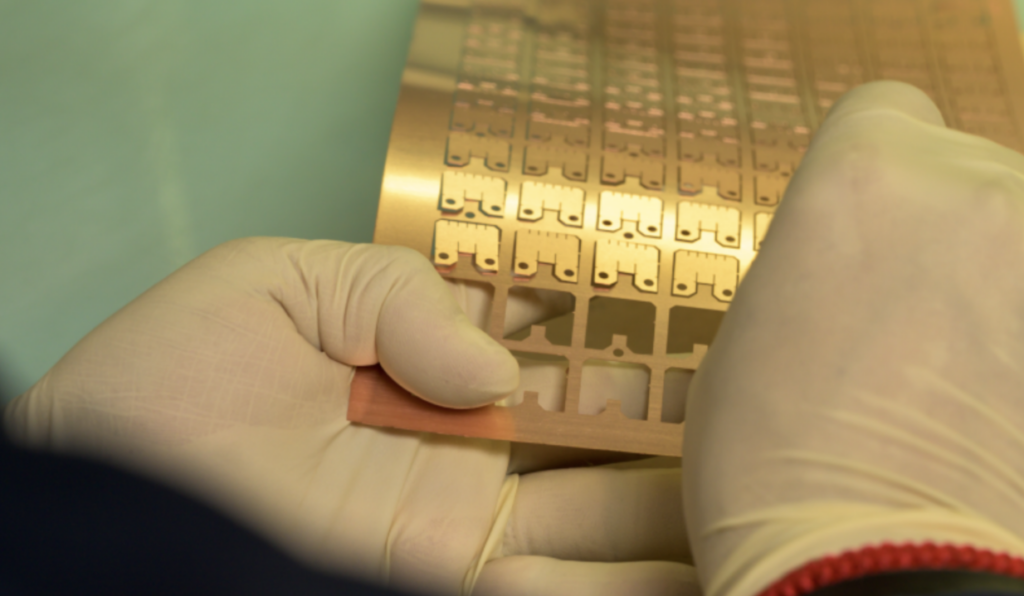At E-Fab, we bring decades of expertise in high-precision metal fabrication, and we take pride in not only delivering top-tier manufacturing solutions but also in educating our clients about the benefits of the technologies we offer. In the realm of non-contact precision metal fabrication, selecting the right manufacturing process is crucial to ensuring optimal performance, durability, and efficiency.
Two of the most widely used techniques in this arena are Photochemical Etching (PCE) and Wire Electrical Discharge Machining (Wire EDM). While both methods provide unique benefits, they also come with certain limitations depending on the application, material type, and design complexity. Both methods are versatile in handling a wide range of materials, including hardened and conductive ones, making them suitable for producing complex and intricate designs.
Choosing the right fabrication method depends on the specific needs of your project. For manufacturers seeking a versatile, precise, and cost-effective solution for intricate metal components, Photochemical Etching (PCE) remains the gold standard. Unlike EDM, which relies on electrically charged wires to cut through metal, PCE uses a controlled chemical process to dissolve unwanted material without introducing mechanical stress, heat-affected zones, or excessive tool wear.
In this series, we continue to explore the differences between PCE and other fabrication technologies, examining their advantages, limitations, and ideal applications. Our next discussion will take a closer look at how PCE compares to Wire EDM, highlighting the key benefits that make PCE the preferred choice for many precision manufacturing needs.
Understanding Photochemical Etching (PCE)
Photochemical Etching (PCE), also known as photochemical milling or photochemical machining (PCM), is a highly precise, cost-effective subtractive manufacturing process used to produce intricate metal components with fine details and tight tolerances. Unlike traditional machining methods that rely on mechanical cutting or thermal processes, PCE utilizes a combination of photoresist technology and chemical etchants to selectively remove material, allowing for the creation of complex patterns without inducing mechanical stress, distortion, or burr formation.
This process involves five essential steps. It starts with metal preparation, where the chosen metal sheet is thoroughly cleaned to ensure optimal adhesion of the photoresist. Next, a light-sensitive photoresist is uniformly applied to both sides of the sheet, serving as a protective coating. During UV exposure and image development, a photomask is placed over the coated sheet and exposed to ultraviolet light, hardening specific areas of the photoresist while the unexposed sections are chemically removed to reveal the bare metal. The chemical etching stage then takes place, where controlled etchants dissolve the exposed metal, creating the desired pattern. Finally, in the stripping and cleaning phase, any remaining photoresist is removed, resulting in a clean, corrosion-free component with high precision.
Understanding Wire Electrical Discharge Machining (Wire EDM)
Wire Electrical Discharge Machining (Wire EDM) is a high-precision, non-contact process that uses a thin, electrically charged wire to cut with extreme accuracy. By generating controlled electrical discharges, it erodes the material without direct mechanical force, making it ideal for intricate geometries, sharp corners, and fine details.
Wire EDM is commonly used for creating dies, molds, medical implants, aerospace components, and complex machine parts with tolerances as tight as ±0.0001 inches. Its non-contact nature reduces the risk of deformation, making it suitable for delicate designs. However, it is slower than other methods, making it less suited for high-volume production.
The effectiveness of using tungsten carbide in various EDM applications is notable, particularly in maintaining the material’s hardness and achieving high precision in cutting processes. Using oil dielectric over water dielectric helps preserve the integrity of tungsten carbide during machining, preventing cobalt depletion and enhancing surface finish quality.

Benefits of Photochemical Etching vs. Wire EDM
While both Photochemical Etching (PCE) and Wire Electrical Discharge Machining (Wire EDM) are precision methods, PCE offers specially designed benefits, such as stress-free processing and no heat-affected zones due to its chemical etching process. This makes PCE ideal for many applications requiring high precision and intricate designs. Photochemical machining plays a crucial role in offering a cost-effective and speedy method for producing intricate metal components with high precision and fine details. However, depending on the material thickness, EDM is still preferred for cutting hardened alloys with 3D contours.
Heat-Affected Zones (HAZ) and Stress
PCE: A chemical process that removes material without heat, eliminating thermal distortion, residual stresses, or micro-cracking in the final component.
EDM: Generates intense localized heat, which can alter the material properties, create heat-affected zones, and require additional post-processing to restore integrity.
Greater Design Flexibility & Complexity
PCE: Highly intricate, burr-free components with fine features, sharp corners, and complex geometries.
EDM: Can produce features in 3D parts, but does not allow for the simultaneous production of multiple identical parts, as each cut must be made individually.
Scalability & Cost Efficiency
PCE: Highly scalable, making it ideal for prototyping and large-scale manufacturing without increasing per-unit costs. Once the digital photo tool is created, multiple parts can be etched at the same time, drastically reducing manufacturing time.
EDM: Machines are slower, singular cutting processes, meaning each part must be machined individually, leading to longer turnaround times and higher expenses for high-volume manufacturing.
Tool Wear and Consumables
PCE: Uses digital masks and chemical etching, meaning there is no physical tool wear or need for replacement, ensuring consistent quality across all parts.
EDM: Machines require a consumable wire electrode that gradually wears out and must be replaced, increasing operational overhead and the likelihood of process variations over time.
Rapid Prototyping
PCE: Offers rapid design changes without affecting productivity, as adjustments can be made digitally without modifying expensive tooling.
EDM: Reprogramming and setup time for each design modification, making it less efficient for quick iterations.
Material Compatibility
PCE: Process nearly any metal, including stainless steel, aluminum, copper, and even delicate foils down to 25 microns.
EDM: Limited to electrically conductive alloys, making it unsuitable for some specialized applications.

Ideal Applications for PCE vs. Wire EDM
Both PCE and EDM are extremely high-quality, precision fabrication methods, but their ideal applications vary based on material type, complexity, volume, and required tolerances.
The printed circuit board industry has played a significant role in the evolution of photochemical machining, utilizing photoresists and etchants to produce highly detailed metal components effectively and economically.
PCE is best suited for thin, intricate, and high-precision metal components, particularly when cost efficiency, scalability, and material integrity are top priorities. Once the material thickness increases, EDM machines can be used for harder alloys that also include extremely tight tolerances or 3D profiling.
Aerospace Components
PCE: Lightweight, high-precision components such as RF shielding, micro-turbine parts, and fuel injector nozzles.
EDM: High-precision turbine blades, engine components, and landing gear parts made from hardened alloys.
Medical Devices
PCE: Precision-etched components for surgical instruments, stents, orthopedic implants, and microfluidic components that require biocompatibility and burr-free finishes.
EDM: Complex surgical tools, orthopedic implants, and precision-machined medical instruments.
Electronics & Semiconductors
PCE: EMI/RFI shielding, lead frames, circuit board components, and micro-precision contacts.
Tool, Dies & Molds:
EDM: Punches, dies, molds, and precision stamping tools.
Automotive & EV:
PCE: Battery current collectors, fuel cell plates, and high-precision cooling plates for thermal management.
EDM: Engine components, transmission parts, and hardened gears.
E-Fab: Your Trusted Partner in Precision Metal Fabrication
With decades of expertise in photochemical etching (PCE), E-Fab offers several key advantages over EDM for industries such as aerospace, medical devices, electronics, and micro-engineering. PCE delivers high-precision, intricate designs, and burr-free finishes without introducing heat-affected zones (HAZ) or material stress, ensuring superior material integrity.
Our advanced etching technology enables rapid output of complex geometries with exceptional accuracy, while EDM is slower and less efficient for high-volume runs. PCE also provides versatile material compatibility, working with a wide range of metals, including ultra-thin foils, which EDM cannot process as effectively. Additionally, PCE offers scalable production and cost-effective prototyping, eliminating the need for expensive tooling and reducing per-unit costs for large-scale manufacturing.
With proven industry expertise and collaborative support, E-Fab ensures that engineers can achieve optimal design solutions while benefiting from the efficiency and flexibility that PCE provides over EDM.
Partner with E-Fab today to bring your precision components to life with unmatched quality and innovation.

